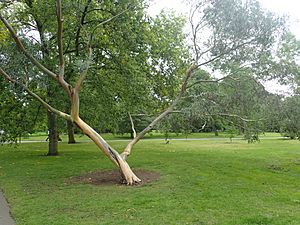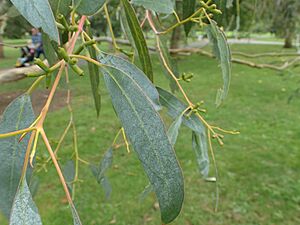Tingiringi gum facts for kids
Quick facts for kids Tingiringi gum |
|
|---|---|
 |
|
| E. glaucescens in Kew Gardens | |
| Scientific classification | |
| Genus: |
Eucalyptus
|
| Species: |
glaucescens
|
| Synonyms | |
|
Eucalyptus gunnii var. glauca H.Deane & Maiden |
|
Eucalyptus glaucescens, commonly known as the Tingiringi gum or Tingaringy gum, is a special plant. It belongs to the myrtle family called Myrtaceae. This tree is found only in south-eastern Australia. It grows as a tall tree or a smaller, bushy plant called a mallee. The Tingiringi gum has smooth bark and dull greyish leaves. You can find it in the higher areas of southern New South Wales and Victoria.
Tingiringi Gum: What Does It Look Like?
The Tingiringi gum is a tree that can grow very tall. It sometimes reaches a height of about 40 to 50 meters (130 to 160 feet). It can also grow as a mallee, which is a smaller, multi-stemmed bush.
Its bark is smooth and can be grey, green, or yellow. The bark peels off in short strips. Sometimes, the lower part of the tree's trunk has rough or stringy bark instead.
The adult leaves of this tree are shaped like a spear. They are a dull greyish-green color. These leaves are usually 60 to 120 millimeters (2.4 to 4.7 inches) long. They are also 12 to 20 millimeters (0.47 to 0.79 inches) wide.
Young leaves are different. They grow in pairs opposite each other. These leaves are heart-shaped or almost round. They do not have a stalk connecting them to the stem.
The flowers grow in groups of three. The flower buds are small, about 5 to 8 millimeters (0.20 to 0.31 inches) long. They are also 3 to 4 millimeters (0.12 to 0.16 inches) wide. The caps on the flower buds are shaped like a cone or half a sphere. They are much shorter than the rest of the bud.
After the flowers, the tree produces fruit. The fruit is shaped like a cup or a cylinder. It is 6 to 12 millimeters (0.24 to 0.47 inches) long. The fruit is also 6 to 10 millimeters (0.24 to 0.39 inches) wide.
How the Tingiringi Gum Got Its Name
The scientific name for this tree is Eucalyptus glaucescens. It was first officially described in 1929. Two scientists, Joseph Maiden and William Blakely, gave it this name. They found a sample of the tree on Tingiringi Mountain.
The name glaucescens comes from a Latin word. The word glaucus means "blue-grey" or "blue-green." So, glaucescens means "becoming blue-grey or blue-green." This describes the color of the tree's leaves.
Where the Tingiringi Gum Grows
The Tingiringi gum grows in special areas. It likes to live in shrubland on rocky slopes made of granite. You can find it on the southern tablelands of New South Wales. Its range extends south from the Australian Capital Territory. It also grows in high mountain areas in Victoria.


